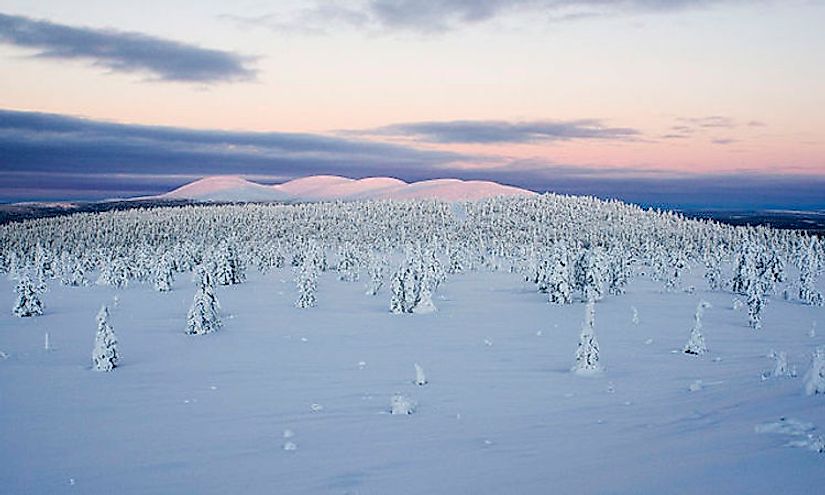Finland's National Parks

The country of Finland is a Nordic country that is located in Northern Europe, bordered by Russia, Sweden, and Norway. There is currently 38 national parks in the country, as well as a number of nature reserves and wilderness reserves. The national parks cover about 2.7% of Finland's land and are all administrated by the Metsähallitus. This article will discuss the three largest national parks in the country.
Finland's Three Biggest National Parks
Pallas-Yllästunturi
The Pallas-Yllästunturi National Park is the third largest in Finland, covering an area of 394 square miles (1,020 square kilometers). The park is found in the Lapland region of northern Finland covering the four municipalities of Enontekiö, Kittilä, Kolari and Muonio. The Pallas-Yllästunturi National Park was established in 2005 when the decision was made to combine the Pallas-Ounastunturi National Park and the Ylläs-Aakenus protected area into one giant national park. The park is mostly made up of two biome types, old-growth forest and muskeg, which is an area made up of acidic soil and dead plants in different stages of decomposition. The major attractions of the park are it's almost 220 miles (350 kilometers) of marked hiking trails, as well as 14 nature trails that provide information on the park's natural features and culture. The fells (mountains) at the park are some of the southernmost places in the country to see arctic animals. The largest fell is Taivaskero, which is 2,654 feet (809 meters) tall and has a memorial at is peak to commemorate when the Olympic torch was lit there in 1952. There are also several lakes in the park, like Lake Vuontisjärvi and Lake Pallasjärvi.
Urho Kekkonen
The Urho Kekkonen National Park is the second largest in Finland, covering an area of 985 square miles (2,550 square kilometers). The park is located in the Lapland region of Finland, covering over the municipalities of Inari, Savukoski, and Sodankylä. The Urho Kekkonen National Park was established back in 1983 and is named after former president and prime minister Urho Kekkonen (1900-1986). The major sites at the park for visitors to see and backpack along are the Suomujoki river, the Aittajärvi lake and the Kiilopää fell. Most backpackers traveling along one of those sites usually end up by the Saariselkä fell line, near the village of Saariselkä at the edge of the park's boundaries.
Lemmenjoki
The Lemmenjoki National Park is the largest in all of Finland, covering an area of 1,100 square miles (2,850 square kilometers). The park is also located in the Lapland region of Finland, covering over the municipalities of Inari and Kittilä. The park was founded way back in 1956, has been expanded twice since its inception and is one of the largest national parks in all of Europe. The national park is named after the 50 miles (80 kilometers) long Lemmenjoki River that runs through the park. The major attraction of the park for tourists is to backpack through the around 40 miles (60 kilometers) of marked paths that even included bridges and boats to cross over paths not accessible by foot. There are also more than ten wilderness huts throughout the park for tourists to stay in, some being free and other having to be paid for. The park also has a gold digging area, with two small airfields nearby to provide faster transportation into and out of the area.
The Importance Of National Parks In Finland
The national parks of Finland, as well as national parks around the world, are important for a number of reasons. These parks help to provide a safe haven for the animals and plants that are found within them. They also give the tourists visiting the national parks a chance to reconnect with nature and for countries to have a positive economic force that also helps to preserve the environment.
Finland's National Parks
| Finland's National Parks | Area |
| Archipelago | 193 square miles |
| Bothnian Bay | 1 square mile |
| Bothnian Sea | 347 square miles |
| Eastern Gulf of Finland | 3 square miles |
| Ekenäs Archipelago | 20 square miles |
| Helvetinjärvi | 19 square miles |
| Hiidenportti | 17 square miles |
| Isojärvi | 7 square miles |
| Kauhaneva-Pohjankangas | 22 square miles |
| Koli | 12 square miles |
| Kolovesi | 9 square miles |
| Southern Konnevesi[3] | 6 square miles |
| Kurjenrahka | 11 square miles |
| Lauhanvuori | 20 square miles |
| Leivonmäki | 11 square miles |
| Lemmenjoki | 1,100 square miles |
| Liesjärvi | 8 square miles |
| Linnansaari | 15 square miles |
| Nuuksio | 17 square miles |
| Oulanka | 104 square miles |
| Päijänne | 5 square miles |
| Pallas-Yllästunturi | 394 square miles |
| Patvinsuo | 41 square miles |
| Petkeljärvi | 2 square miles |
| Puurijärvi-Isosuo | 10 square miles |
| Pyhä-Häkki | 5 square miles |
| Pyhä-Luosto | 55 square miles |
| Repovesi | 6 square miles |
| Riisitunturi | 30 square miles |
| Rokua | 2 square miles |
| Salamajärvi | 24 square miles |
| Seitseminen | 18 square miles |
| Sipoonkorpi | 7 square miles |
| Syöte | 115 square miles |
| Tiilikkajärvi | 13 square miles |
| Torronsuo | 10 square miles |
| Urho Kekkonen | 985 square miles |
| Valkmusa | 7 square miles |











